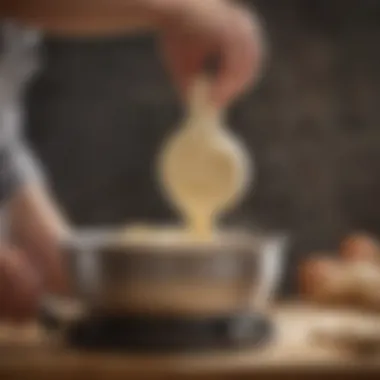Food Mixer Attachments: Essential Tools for Cooks


Intro
In the realm of culinary arts, food mixers have become indispensable tools. They significantly streamline the cooking process, allowing for efficient preparation of various dishes. However, the true versatility of food mixers is unlocked through the use of attachments. This guide delves into the utility of these attachments, presenting a thorough exploration of their functions, maintenance, and optimal usage to enhance your cooking experience.
Recipe Overview
Brief Description of the Dish
While the guide does not focus on a single dish, understanding the various food mixer attachments opens up a world of possibilities in the kitchen. From preparing bread dough to creating creamy frostings, each attachment caters to specific needs, thus enabling diverse culinary creations.
Key Ingredients
Key ingredients may vary depending on your culinary choices. However, some staple items include:
- Flours: All-purpose, whole wheat, or specialty flours for baking.
- Sugars: Granulated, powdered, or brown sugar for various recipes.
- Dairy: Milk, butter, and cream for rich textures.
- Eggs: Essential for binding many mixtures together.
- Flavorings: Vanilla extract, spices, or citrus zest to enhance dishes.
Understanding how attachments can manipulate these ingredients can transform simple components into culinary masterpieces.
Preparation Guidelines
Step-by-Step Instructions
- Select the Right Attachment: Identify the task at hand. Use the whisk for whipping, the paddle for mixing, and the dough hook for kneading.
- Arrange Ingredients: Have all your ingredients prepared and measured before starting. This practice ensures smooth workflow.
- Layer Ingredients Wisely: For best results, add dry ingredients in stages, gradually incorporating wet elements to achieve desired consistency.
- Monitor Your Mixture: Adjust speed settings on the mixer to suit the attachment and desired result. Start slow to prevent splatters, then increase as needed.
- Clean Up Promptly: After each use, detach the mixer attachment and clean to maintain hygiene and prolong the longevity of the tools.
Preparation Tips and Tricks
- Always refer to the mixer’s handbook for specific instructions related to yours.
- Try to let butter soften to room temperature before mixing for better incorporation.
- Experiment with different speed settings to master the texture of your mixtures.
"The right attachment can make a significant difference in achieving the texture and consistency you desire in your culinary endeavors."
By understanding and utilizing food mixer attachments effectively, cooks of all skill levels can improve their culinary output, making the kitchen a more efficient and enjoyable place.
Preamble to Food Mixer Attachments
Understanding food mixer attachments is essential for anyone serious about enhancing their culinary skills. These tools allow users to perform a variety of tasks with ease, making cooking and baking more efficient. You can not only save time but also achieve better consistency and quality in your dishes by using the correct attachments.
Food mixer attachments serve a specific function, yet their roles can significantly impact the overall cooking experience. By recognizing which attachment suits your needs, you can unlock new culinary techniques, streamline your workflows, and elevate your gastronomic creations. This guide is designed to aid both novice cooks and experienced chefs in navigating the world of food mixer attachments, ensuring they select the best options for their purposes.
Definition and Purpose
Food mixer attachments are designed to fit onto various stand mixers, allowing users to mix, knead, whip, or prepare different food items. They typically include whisks, dough hooks, and other specialized attachments tailored for specific cooking tasks. The main purpose of these attachments is not only to improve efficiency but also to enhance the quality of the finished product.
When you use the proper attachment for a job, it can make a significant difference in the texture and consistency of your ingredients. For example, a whisk is excellent for aerating ingredients like cream or eggs, while a dough hook is necessary for kneading bread or pizza dough effectively. By understanding the functions and advantages of these attachments, you can make more informed choices that benefit your culinary endeavors.
The Evolution of Food Mixers
The food mixer has undergone significant transformation since its inception in the late 19th century. Originally a manual device, the first electric mixer was introduced in the 1920s, forever changing how people cooked and baked. With the advent of new technologies and designs, food mixers have increased in power and versatility.


Today, various brands offer mixers equipped with multiple attachments for diverse uses, from basic mixing to advanced preparation techniques. Innovations such as planetary mixing action allow for thorough blending while reducing the risk of batch inconsistency. As a result, food mixers have become indispensable kitchen appliances for both amateur cooks and professional chefs.
The journey of food mixers continues as new attachments emerge, offering enhanced functionality and versatility. By embracing these advancements, culinary enthusiasts can greatly enrich their cooking experience.
Types of Food Mixer Attachments
Food mixer attachments can significantly impact your cooking experience. Understanding different types enables cooks to utilize their mixers to the fullest. Each attachment serves a unique function, allowing for greater versatility in meal preparation. Choosing the right attachment can enhance the quality of your dishes, streamline processes, and ultimately save you time in the kitchen. In this section, we will explore the primary varieties of food mixer attachments that professional and amateur cooks often use.
Standard Attachments: Overview
Standard attachments come pre-packaged with most food mixers, and they typically include mixing paddles, dough hooks, and whisks. These basic tools play essential roles in various culinary tasks. The mixing paddle is perfect for general mixing, allowing ingredients to blend uniformly. Dough hooks are designed specifically for kneading bread dough efficiently. Finally, whisks are used for incorporating air into mixtures, which is critical for achieving desired textures in batters and creams. Each of these attachments offers distinct benefits that cater to different mixing requirements, empowering users to tackle diverse recipes successfully.
Mixing Bowls
Mixing bowls are integral to the food mixer system. Their design varies to accommodate different attachment types, and the size can affect preparation efficiency. For instance, a larger bowl can handle bigger batches, making it easier to mix ingredients without overflow. Wider bowls allow for better air circulation when whipping, leading to lighter mixtures. When selecting a mixing bowl, consider materials such as glass or stainless steel for durability and ease of cleaning. Investing in a good quality bowl can enhance your overall mixer experience, allowing you to explore a variety of dishes.
Dough Hooks
Dough hooks are specially crafted for kneading. Their shape mimics the motion of hand-kneading, which is essential for gluten development in bread. This attachment saves time and effort for bakers. Many home chefs find dough preparation laborious; however, with a dough hook, the mixer takes care of much of the hard work. You can use dough hooks with different types of dough, improving consistency in your bread-making. When choosing a dough hook, ensure it is compatible with your mixer model for optimal performance.
Whisks
Whisks are essential for tasks requiring aeration, like whipping cream or beating egg whites. The design of a whisk attachment allows for maximum incorporation of air, resulting in fluffier mixtures. Using a whisk attachment is straightforward; it requires no special technique, making it accessible for all skill levels. Many mixers come with different whisk options: some are more robust for thick mixtures, while others are designed for delicate sauces. Testing a few can help you identify what works best for your needs.
Pasta Makers
Pasta makers are specialized attachments that allow you to create fresh pasta from scratch. They typically come with various roller settings, enabling you to adjust the thickness of the dough. This attachment is particularly valuable for those who appreciate the texture of homemade pasta. Fresh pasta cooks more quickly and has a richer flavor compared to dried varieties. Making pasta at home can be a rewarding process, yielding superior results and enhancing your culinary repertoire.
Grinders
Grinders are versatile attachments used for processing meat, spices, or even vegetables. Having a grinder enables you to create custom blends, allowing for tailored flavors that store-bought products cannot match. For example, if you enjoy making your own sausage, a grinder is indispensable. It offers a solution to control texture and spice ratios, enhancing your cooking creativity. Moreover, grinding ingredients fresh can elevate your dish's overall taste.
Slicers and Shredders
Slicers and shredders are another important category of food mixer attachments. These tools help in preparing ingredients for recipes such as salads or garnishes. With these attachments, slicing vegetables or shredding cheese becomes quick and easy. This efficiency allows home cooks to save significant prep time, making it easier to manage meal prep. Slicers usually offer different thickness settings, enabling various cutting styles. Investing in a high-quality slicer or shredder can make food preparation less tedious and more enjoyable.
By understanding these different types of food mixer attachments, culinary enthusiasts can make informed decisions that improve their cooking experiences. Each attachment has unique functionalities that cater to specific culinary tasks, allowing for greater creativity in the kitchen.
Selecting the Right Attachment
Choosing the right attachment for your food mixer is critical for optimizing your cooking experience. The right attachment not only enhances the efficiency of your tasks but also ensures better results in the kitchen. Given the variety of attachments available, it's important to understand how each can fulfill different cooking needs.
Assessing Your Cooking Needs
Before deciding on attachments, take a moment to reflect on your cooking habits. What type of meals do you prepare most often? If you frequently bake, a dough hook and whisk may be essential. Alternatively, if you enjoy making homemade pasta or sausages, then specific attachments for these tasks are beneficial.
Consider how often you cook and the complexity of your recipes. If you are an occasional cook, a versatile attachment might serve you better than specialized tools. Identifying your common cooking tasks helps in narrowing down your options effectively.
Compatibility with Your Mixer


Not all attachments work with every mixer. Each model has specific requirements and sizes. Before purchasing an attachment, check its compatibility with your mixer. This information is usually found in the user manual or on the manufacturer's official website.
Attachments that are not designed for your mixer can lead to performance issues or even damage. Investing time to verify compatibility can save frustration later.
Quality and Durability Considerations
Quality matters when selecting food mixer attachments. High-quality materials contribute to durability and longevity. Look for stainless steel or heavy-duty plastic that can withstand frequent use.
Cheap attachments might seem appealing at first, but they often wear down quickly or break. Investing in premium attachments ensures consistent performance and reduces the need for replacements.
"Choosing high-quality attachments can make a significant difference in your cooking efficiency and overall experience in the kitchen."
Benefits of Using Food Mixer Attachments
Food mixer attachments are more than just gadgets in the kitchen; they serve vital functions that enhance cooking efficiency and outcomes. Understanding their benefits helps culinary enthusiasts integrate these tools into their cooking processes, streamlining tasks and elevating meal quality. Let us explore three key benefits: time efficiency in meal preparation, consistency in mixing, and versatility in cooking techniques.
Time Efficiency in Meal Preparation
In the fast-paced environment of a modern kitchen, time efficiency is crucial. Food mixer attachments significantly reduce the time it takes to prepare meals. For example, using a dough hook minimizes the manual effort of kneading, which can be labor-intensive and physically taxing. When making bread or pastries, having a mixer do the hard work allows the cook to attend to other tasks, such as preparing fillings or setting the table.
Moreover, attachments like whisks automate the process of whipping eggs or cream, producing results much faster than manual methods. This time savings can extend to large batches, making it easier to prepare food for gatherings or meal prep. By optimizing the cooking process, food mixer attachments help cooks focus on creativity without being overwhelmed by time constraints.
Consistency in Mixing and Preparing Ingredients
The precision offered by food mixer attachments ensures uniformity in mixing. Consistent mixing is vital in baking to achieve the right texture. An uneven mixture can lead to poor rise in cakes or uneven textures in dough. Attachments like the flat beater and whisk provide the reliable incorporation of ingredients, leading to better results in baked goods and other dishes that require thorough mixing.
Maintaining the same mixing speed and technique each time improves not only the final product but also contributes to repeatability in recipes. Whether you’re preparing a delicate soufflé or hearty cookie dough, the ability to produce consistent results builds confidence in any cook. With food mixer attachments, there's less room for error.
Versatility in Cooking Techniques
Food mixer attachments are not limited to just one purpose. They enhance the versatility of a standard mixer, turning it into a multi-functional kitchen appliance. For instance, a pasta maker attachment allows for fresh pasta production, while a grinder can turn meat and vegetables into ground mixtures for various recipes.
The ability to switch attachments enables cooks to explore different culinary techniques without investing in multiple appliances. This versatility maximizes kitchen space and encourages experimentation. Cooks can diversify their skills, moving from mixing to grinding and even to pasta-making, thereby enriching their culinary repertoire.
"Using food mixer attachments transforms your cooking experience, allowing greater efficiency and creativity in the kitchen."
In summary, the benefits of using food mixer attachments are immense. They save time, ensure consistency, and allow for versatile cooking techniques. Understanding these advantages enables enthusiasts to select the right attachment for their needs and enhance their cooking skills. In the kitchen, these tools are not just accessories; they are valuable allies in the pursuit of culinary excellence.
Usage Tips for Food Mixer Attachments
Understanding how to effectively use food mixer attachments is crucial for maximizing their potential in the kitchen. Correct usage ensures that you reach optimal efficiency when preparing various dishes. This section elucidates the significance of proper setup, appropriate speed control, and diligent cleaning practices for food mixer attachments, making culinary tasks simpler and achieving desired results more consistently.
Proper Setup and Adjustment
Proper setup is fundamental to ensure that food mixer attachments function as intended. When connecting attachments like dough hooks or whisks, one must ensure they are securely locked in place. A loose attachment can lead to uneven mixing or even damage to the mixer. It’s advisable to refer to the manufacturer’s manual for specific installation instructions.
Before starting, check that the machine is switched off, and all components are clean and dry. Ensure that the mixing bowl is properly aligned with the mixer base. Misalignment may cause ingredients to spill out, leading to waste and mess. Remember, a well-settled bowl provides a stable base for efficient mixing.


"A little attention to setup can prevent a lot of chaos in the kitchen."
Operating Speed and Timing Guidelines
Operating speed and timing are essential elements that influence the outcome of your culinary endeavors. Each attachment serves different purposes, and understanding the ideal speed for each can lead to better results. For instance, dough hooks work best at low speeds, while whisks are more effective at higher speeds for aerating mixtures.
It is also pivotal to monitor the timing during operation. Overmixing can negatively impact texture, especially in baked goods. Using a timer can be a helpful practice to prevent overworking mixture. Start at a lower speed to combine ingredients, then gradually increase as needed. Adjust speed as appropriate based on the consistency and quantity of the ingredients.
Cleaning and Maintenance Best Practices
Cleaning food mixer attachments is not just a matter of hygiene; it also affects their performance and longevity. After each use, immediately detach and wash all components, especially those that come into direct contact with food. A simple warm soapy water wash is usually sufficient, but be cautious with parts that may require gentle handling.
For stubborn residues, soaking the attachments in warm water can ease the cleaning process. Make sure to dry them thoroughly to prevent moisture damage. Regular maintenance checks, such as inspecting for wear or any parts that may need replacement, ensure continued efficiency.
In summary, understanding the right setup, operating speeds, and maintenance practices can significantly enhance your experience with food mixer attachments. Following these usage tips allows both novice and seasoned cooks to optimize their mixer’s potential, facilitating seamless culinary creations.
Common Challenges and Solutions
Food mixer attachments greatly enhance efficiency in the kitchen but they also present unique challenges. Acknowledging and addressing these issues is vital for culinary enthusiasts aiming to optimize their cooking experience. This section explores common challenges faced with food mixer attachments and proposes practical solutions to overcome them. Doing so not only improves performance but also ensures that users can achieve the best outcomes in their culinary pursuits.
Mixing Inconsistencies
Mixing inconsistencies can often arise when using food mixer attachments, particularly with recipes that require uniform texture. For instance, cake batter may end up lumpy or unevenly mixed if the appropriate attachment or speed setting is not used. This inconsistency can lead to disappointing results, often requiring additional time and effort to correct.
To mitigate this challenge, it is crucial to select the right attachment based on the task at hand. The use of flat beater for cake batters or the dough hook for bread is fundamental. Each attachment is designed to perform distinct functions, influencing how ingredients mix together.
Furthermore, users should pay attention to the speed settings of the mixer. Starting at a lower speed can prevent ingredients from splattering and ensure they mix together more cohesively. Gradually increasing the speed can enhance the mixing process without risking inconsistencies.
Finally, regularly monitoring the mixture while in progress helps. Taking short breaks to scrape down the sides of the bowl is a simple way to ensure all ingredients are thoroughly integrated. This attention to detail can significantly improve the final product, resulting in a more appealing dish.
"Careful monitoring and selecting the proper attachment can eliminate most mixing discrepancies."
Attachment Compatibility Issues
Another common challenge is the compatibility of attachments with the mixer. Not all attachments fit all mixers, which can lead to frustration during the cooking process. If an attachment does not securely fit or connect, it can hinder performance or even cause damage to the mixer.
Before purchasing, users should investigate which attachments are compatible with their specific mixer model. Many manufacturers provide lists of compatible attachments, making it easier to choose the right options.
Additionally, investing in attachments from the same brand as the mixer often guarantees a better fit. However, some third-party options can be just as effective if they meet the proper specifications and quality standards.
Regular maintenance of the attachments is also essential. Ensuring that the connection points are clean and free from debris will help maintain functionality and extend the life of the attachments. Like any tool, proper care can prevent compatibility issues and promote reliability during cooking.
In summary, understanding the common challenges with food mixer attachments can greatly enhance the cooking experience. By addressing mixing inconsistencies and attachment compatibility issues, culinary enthusiasts can utilize their mixers effectively, achieving remarkable results in their kitchen endeavors.
Ending
Food mixer attachments play a significant role in the kitchen for anyone who enjoys cooking or baking. As discussed in this article, these attachments bring versatility, efficiency, and precision to culinary tasks. They enable users to explore a breadth of cooking techniques with ease, making meal preparation less daunting and more enjoyable.
Recap of Key Points
In this guide, we reviewed several important aspects regarding food mixer attachments:
- Types: We categorized attachments into standard types, including dough hooks, whisks, pasta makers, grinders, and slicers. Each serves a distinct purpose, expanding the capabilities of a food mixer.
- Benefits: Attachments offer time efficiency, consistent results, and versatility in preparing various dishes. They can significantly enhance the cooking experience.
- Usage Tips: Proper setup and maintenance are crucial for optimal performance. Understanding speed and timing is essential to achieving the desired consistency in mixing.
- Challenges: Common issues may arise such as mixing inconsistencies and compatibility problems. Recognizing these challenges allows users to troubleshoot more effectively.
The information gathered throughout this article emphasizes that investing in the right food mixer attachments can transform cooking methods. A thoughtful approach to selection and usage will yield better culinary outcomes. By understanding the available options and best practices, culinary enthusiasts can greatly enhance their kitchen skills.







